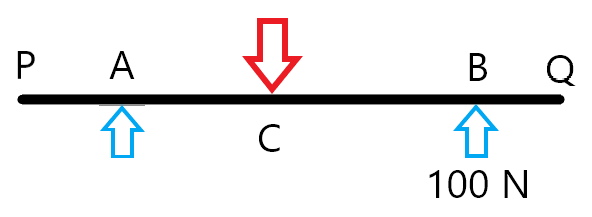(a) A body of mass 5 kg is placed on a smooth plane inclined at
(a) A body of mass 5 kg is placed on a smooth plane inclined at an angle 30° to the horizontal. Find the magnitude of the force: (i) acting parallel to the plane (ii) required to keep the body in equilibrium. [Take g = \(10 ms^{-2}\)].
(b) A uniform plank PQ of length 10m and mass m kg rests on two supports A and B, where |PA| = |BQ| = 1m. A load of mass 8 kg is placed on the plank at point C such that |AC| = 3.5 m. If the reaction at B is 100 N, calculate the (i) value of m (ii) reaction at A. [Take g = \(10 ms^{-2}\)].
Explanation
.jpg)
(i) Force parallel to plane = \(mg \sin 30\)
= \(5 \times 10 \times 0.5 \)
= \(25 N\)
(ii) Force required to keep the body in equilibrium
= \(mg \sin 30 - \mu R\)
= \(25 - \mu \times 5 \times \frac{5\sqrt{3}}{2}\)
= \(25(1 - \mu) \frac{\sqrt{3}}{2}\)
b)
Since the plank does not move, all forces and torques are balanced. Forces:
RA + RB - mCg - mpg=0,
torques (consider A as the pivot):
\(\frac{mp}{10}\)g ⋅ 0.5 − \(\frac{9}{10}\)mp?g⋅4.5 −mC?g⋅3.5+100⋅8=0
mp?=13 kg,
RA?=110 N.

Post an Explanation Or Report an Error
Your email address will not be published. Required fields are marked *